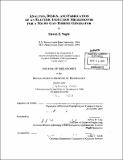| dc.contributor.advisor | Jeffrey H. Lang. | en_US |
| dc.contributor.author | Nagle, Steven F. (Steven Francis), 1972- | en_US |
| dc.contributor.other | Massachusetts Institute of Technology. Dept. of Electrical Engineering and Computer Science. | en_US |
| dc.date.accessioned | 2005-08-23T15:06:51Z | |
| dc.date.available | 2005-08-23T15:06:51Z | |
| dc.date.copyright | 2000 | en_US |
| dc.date.issued | 2001 | en_US |
| dc.identifier.uri | http://hdl.handle.net/1721.1/8761 | |
| dc.description | Thesis (Ph.D.)--Massachusetts Institute of Technology, Dept. of Electrical Engineering and Computer Science, February 2001. | en_US |
| dc.description | Includes bibliographical references (p. 223-227). | en_US |
| dc.description.abstract | This thesis presents the analysis, design, fabrication, and testing of the first axial-gap electric induction micromotor, and the first controlled measurement of electric micromotor torque using integrated mechanical springs. Electric induction micromotors offer several advantages over electric variable capacitance micromotors and magnetic micromotors: neither rotor position nor speed need be known to achieve good performance; perfect sinusoids can be used for actuation to eliminate switching losses without loss of motor performance. In addition, the motor is fabricated from IC-compatible materials. The tethered motor is a metrology device. To eliminate bearings and all friction forces, the rotor is attached to fixed supports by single-crystal silicon tethers that are calibrated after fabrication. The tethers are relatively compliant in the azimuthal plane, but stiff axially. This enables accurate measurement of in-plane displacements, free from losses, while preventing out-of-plane displacements that would alter the gap. Ideally, the micromotor is fabricated from two fusion-bonded wafers in a process of 189 steps using 13 masks. Process complication comes from several sources. First, the stator structure uses a damascene insulator process to provide very thick passivation. Second, the rotor charge relaxation time constant is adjusted using a moderately Boron-doped polysilicon conductor. Third, tethers are defined by a through-wafer etch to be 385 jim tall and only 8 jim wide. Finally, the stator and rotor wafer are to be fusion bonded at the wafer level, although this was not carried out for the tested motor; it was assembled by hand with epoxy. Torque is measured as high as 0.220 [mu]N-m with 90 V square-wave actuation. Torque is shown to be consistent with models and the torque curves are shown to shift with rotor conductivity as expected with reference to a magnetic induction machine. The measurements are consistent with a gap of 12 [mu]m, which is shown to be a result of the hand-assembly process. Bonding would yield a gap of 3 [mu]m, making torque of 3 [mu]N-m possible at the same voltage. | en_US |
| dc.description.statementofresponsibility | by Steven F. Nagle. | en_US |
| dc.format.extent | 227 p. | en_US |
| dc.format.extent | 17913315 bytes | |
| dc.format.extent | 17913063 bytes | |
| dc.format.mimetype | application/pdf | |
| dc.format.mimetype | application/pdf | |
| dc.language.iso | eng | en_US |
| dc.publisher | Massachusetts Institute of Technology | en_US |
| dc.rights | M.I.T. theses are protected by copyright. They may be viewed from this source for any purpose, but reproduction or distribution in any format is prohibited without written permission. See provided URL for inquiries about permission. | en_US |
| dc.rights.uri | http://dspace.mit.edu/handle/1721.1/7582 | |
| dc.subject | Electrical Engineering and Computer Science. | en_US |
| dc.title | Analysis, design, and fabrication of an electric induction micromotor for a micro gas-turbine generator | en_US |
| dc.type | Thesis | en_US |
| dc.description.degree | Ph.D. | en_US |
| dc.contributor.department | Massachusetts Institute of Technology. Department of Electrical Engineering and Computer Science | |
| dc.identifier.oclc | 48117574 | en_US |
